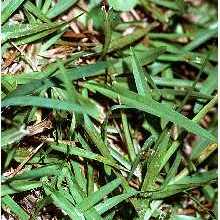Perennial, 250-600 mm high, strongly stoloniferous, forming dense swards; culm nodes glabrous. Leaf blade 200 x 8 mm, rounded at apex; ligule a fringed membrane. Inflorescence digitate or subdigitate, of 2-many slender racemes; spikelets adaxial on branches and solitary at point of attachment. Spikelet 2 x 1 mm, dorsiventrally compressed, awnless; glumes unequal; lower glume absent; upper glume and lower lemma similar, backs turned away from rachis. Florets 2; lower floret sterile, lemma without median nerve; upper floret bisexual, lemma as long as spikelet, 4-nerved, glabrous, entire, margins narrow, inrolled and covering only edges of palea; anther 0.7-1.0 mm long. Flowering time Dec.-May.
Perennial with creeping stolons. Culms compressed, 15–50 cm tall, nodes glabrous. Leaf sheaths compressed, strongly keeled; leaf blades broadly linear, folded, 5–20 × 0.3–0.6 cm, apex obtuse; ligule ca. 0.2 mm. Racemes 2–4, 2-paired, any others spaced slightly below, 3–8 cm, only slightly diverging; rachis glabrous. Spikelets oblong-elliptic, 1.5–2 mm, pilose near margins and apex or subglabrous, apex subacute; upper glume and lower lemma 2–4-veined, midvein absent; upper lemma pale, ovate, as long as spikelet, obtuse with a short apical tuft of hairs; stigmas purple. Fl. and fr. summer–autumn. 2n = 54, 80.
Perennial, stoloniferous, up to 0.6 m high, strongly stoloniferous, forming dense swards. Culm nodes glabrous. Leaf blades up to 200 mm long, 8 mm wide, rounded at tip. Spikelets 2 mm long, 1 mm wide; female-fertile (upper) lemma as long as spikelet.

